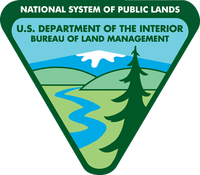
About FlashAlert on Twitter:
FlashAlert utilizes the free service Twitter to distribute emergency text messages. While you are welcome to register your cell phone text message address directly into the FlashAlert system, we recommend that you simply "follow" the FlashAlert account for Bureau of Land Management Ore. & Wash. by clicking on the link below and logging in to (or creating) your free Twitter account. Twitter sends messages out exceptionally fast thanks to arrangements they have made with the cell phone companies.
Agency builds on efforts to protect sagebrush communities in region using fuel breaks to combat wildfires
BOISE, Idaho – Today, the Bureau of Land Management (BLM) released the record of decision for the Fuels Reduction and Rangeland Restoration Programmatic Environmental Impact Statement in the Great Basin. This record of decision provides for treatment of undesired vegetation communities within a 38.5-million-acre potential area that includes portions of California, Idaho, Nevada, Oregon, Utah and Washington.
“Finalizing this effort today is the culmination of the President and the Secretary’s historic efforts to meaningfully address wildfire risks across the West,” said Casey Hammond, Principal Deputy Assistant Secretary for Land and Minerals Management. “From creating new administrative tools to completing environmental analyses allowing for strategic rangeland treatments, the Department has actively led the way in reducing fuel loads and the threat of catastrophic wildfires.”
The Fuels Reduction and Rangeland Restoration Programmatic Environmental Impact Statement analyzes the environmental effects of fuels reduction projects, invasive species treatments, and vegetation restoration work within important sagebrush communities. Local BLM District and Field Offices will plan and implement fuels reduction and rangeland restoration projects using manual, chemical and mechanical treatments, including prescribed fire, seeding and targeted grazing.
This record of decision builds on a complementary planning effort – the Programmatic Environmental Impact Statement for Fuel Breaks in the Great Basin – that the BLM completed in April 2020. That document provides for the construction and maintenance of a system of up to 11,000 miles of strategically placed fuel breaks to control wildfires. To date, the BLM has completed over 1,000 miles of fuels breaks as part of this historic effort.
These efforts are part of a larger national wildfire reduction strategy guided by President Trump’s Executive Order 13855 – Promoting Active Management of America’s Forests, Rangelands, and Other Federal Lands to Improve Conditions and Reduce Wildfire Risk, as well as Secretary’s Order 3372 – Reducing Wildfire Risks on Department of the Interior Land through Active Management. Under the leadership of President Trump and Secretary Bernhardt, the BLM significantly reduced hazardous fuel loads in fire-prone areas by treating more than 782,000 acres using a variety of active management vegetation treatments including mechanical, biological, and chemical tools as well as prescribed fire. The Department of the Interior has treated 5.4 million acres of land since 2017 and a ten-year best, 1.5 million acres in Fiscal Year 2020.
Over the last four years, the BLM has accomplished significant fuels management goals. In fiscal year 2017, the BLM fuels program accomplished more than 650,000 acres of fuels treatments; 480,000 of those treatment acres focused on the protection, conservation and restoration of sagebrush ecosystems. In fiscal year 2018, the BLM accomplished 667,000 acres of fuels treatment (53 percent) of the total 1,266,000 acres accomplished by all DOI Bureaus. In fiscal year 2019, the BLM accomplished more than 846,000 acres of fuels treatment (62 percent) of the total 1.3 million acres accomplished by all Department of the Interior bureaus.
Intact sagebrush communities are disappearing within the Great Basin due to the encroachment of pinyon-juniper and increased size and severity of wildfires which typically lead to the spread of invasive annual grasses. Approximately 45 percent of the historic range of sagebrush has been lost. Fuels reduction and rangeland restoration treatments can reduce fire severity, increase sagebrush communities’ resistance to invasive annual grasses and improve their ability to recover after wildfires. The BLM has extensively documented the effectiveness of reducing fuels and performing restoration treatments in the programmatic environmental impact statement.
This record of decision and programmatic environmental impact statement do not authorize specific projects. Local BLM District and Field Offices within the Great Basin will use the programmatic environmental impact statement to comply with National Environmental Policy Act requirements when planning and analyzing specific local fuels reduction and rangeland restoration projects to allow for more rapid implementation.
The BLM made the final programmatic environmental impact statement for Fuels Reduction and Rangeland Restoration in the Great Basin available for public review on Nov. 27, 2020.
An electronic copy of the record of decision, the final programmatic environmental impact statement for Fuels Reduction and Rangeland Restoration in the Great Basin and associated documents are available on the BLM Land Use Planning and NEPA register at https://eplanning.blm.gov/eplanning-ui/project/122968/570
-BLM-
The BLM manages more than 245 million acres of public land located primarily in the 11 Western states and Alaska. The BLM also administers 700 million acres of sub-surface mineral estate throughout the nation. In fiscal year 2018, the diverse activities authorized on BLM-managed lands generated $105 billion in economic output across the country. This economic activity supported 471,000 jobs and contributed substantial revenue to the U.S. Treasury and state governments, mostly through royalties on minerals.